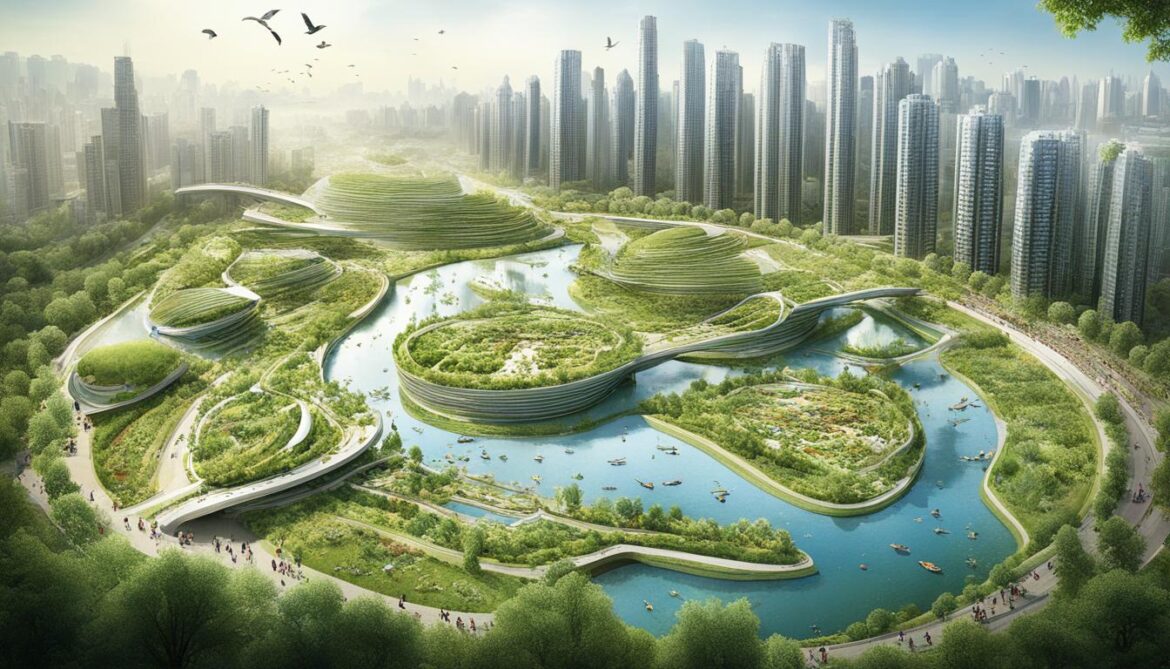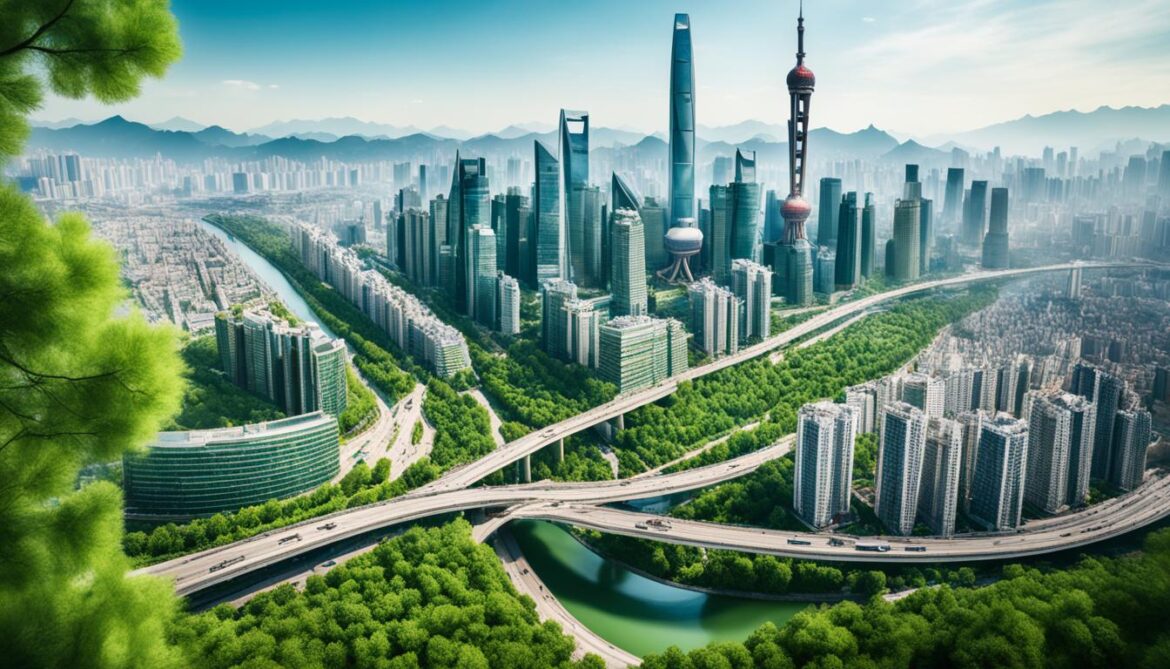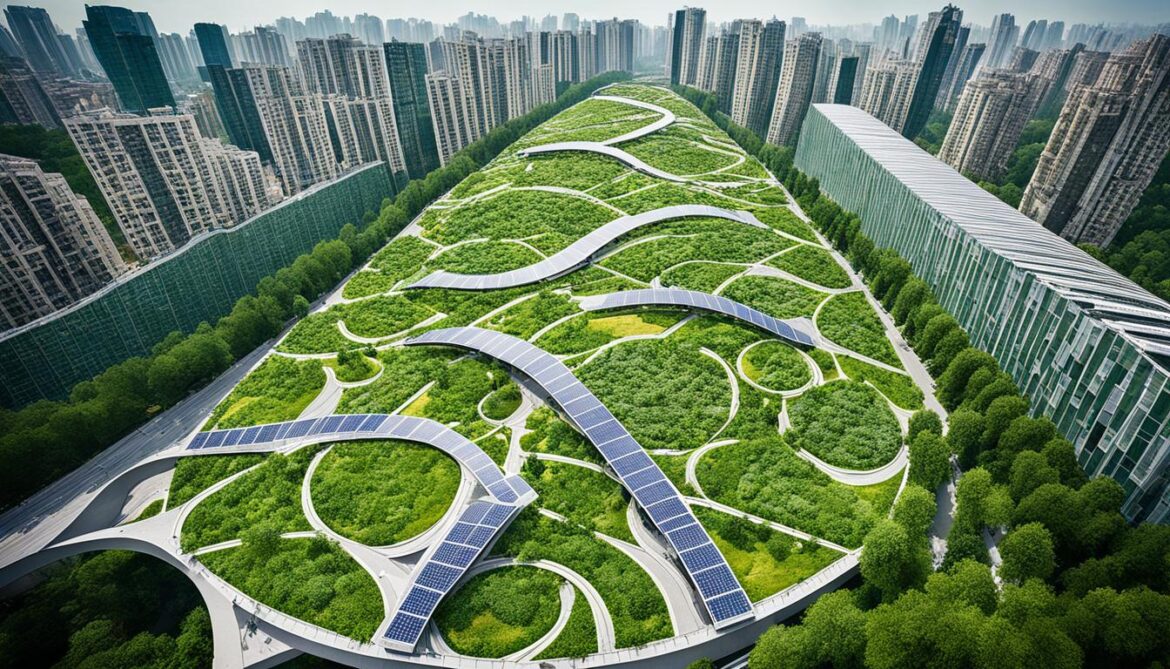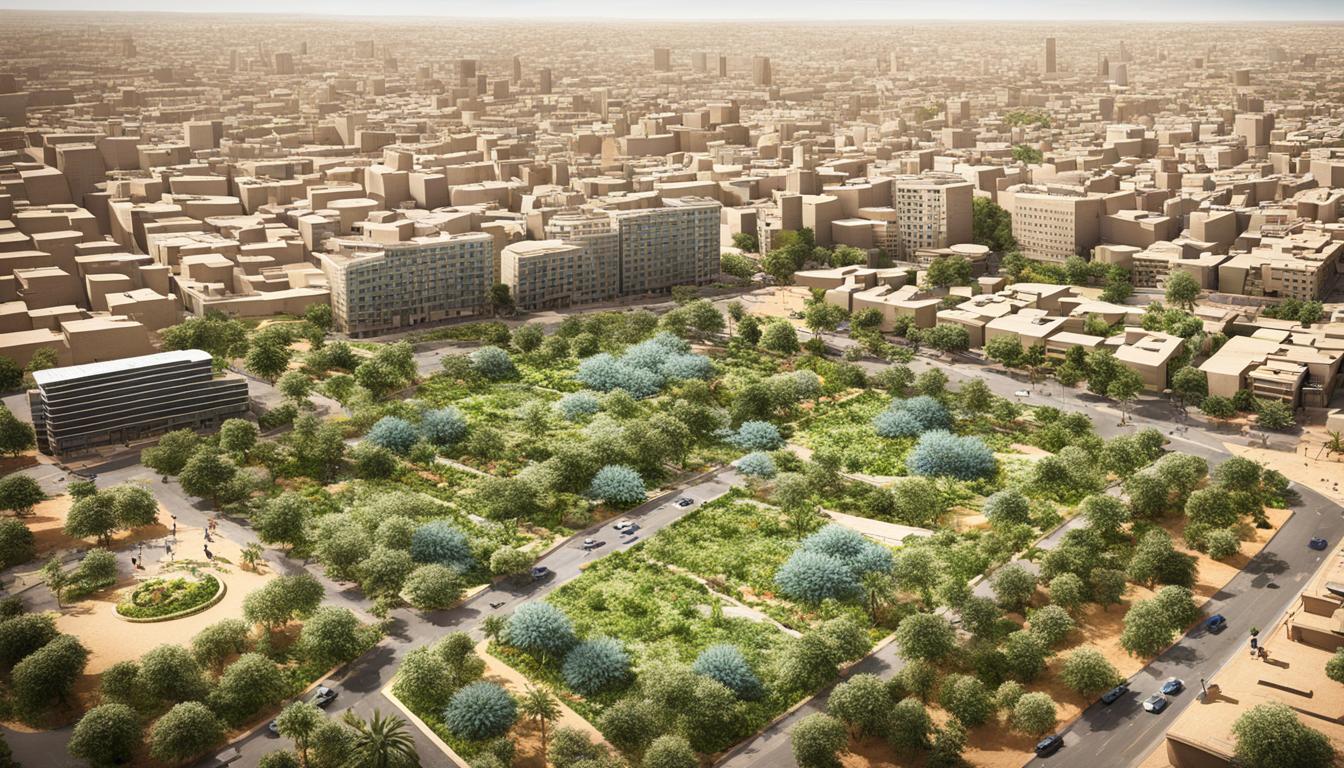China Biodiversity and the Built Environment
China’s rapid urban development has had a profound impact on its biodiversity and the built environment. As the country continues to grow and urbanize at an unprecedented rate, it has become crucial to examine the relationship between environmental conservation, sustainable development, and the preservation of biodiversity.
In this section, we will analyze the specific case of Shanghai, a city with the highest urbanization rate in China, to understand the challenges and opportunities it presents in terms of biodiversity conservation and sustainable urban planning. By exploring the importance of biodiversity in the built environment, the impact of biodiversity loss on ecosystems and society, and the role of China’s infrastructure initiatives in biodiversity loss, we can gain valuable insights into the current state and future prospects of China’s biodiversity.
Key Takeaways
- Biodiversity loss is a pressing issue in China’s rapidly developing built environment.
- Sustainable development and environmental conservation are essential for preserving biodiversity.
- The impact of biodiversity loss extends beyond ecosystems, affecting economies and human health.
- China’s One Belt, One Road initiative has raised concerns about habitat destruction and species extinction.
- Proactive measures, such as incorporating nature-based solutions and green infrastructure, are needed to protect and enhance biodiversity in urban areas.
The Importance of Biodiversity in the Built Environment
Biodiversity plays a critical role in the built environment, providing a multitude of benefits that are essential for the well-being of our cities. Urban biodiversity in China not only contributes to the overall health of ecosystems but also offers numerous nature-based solutions to address sustainability challenges. Incorporating these solutions in urban planning is key to creating more sustainable and environmentally friendly cities in China.
Urban biodiversity in China brings forth a wide range of ecosystem services that are vital for the functioning of the built environment. These services include regulating natural phenomena such as climate regulation, water purification, and flood control. They also provide resources like food, medicine, and raw materials, while supporting life processes such as pollination and nutrient cycling. Additionally, urban biodiversity enriches cultural experiences, providing spaces for recreation, relaxation, and inspiration.
In order to sustain biodiversity in urban areas and promote sustainable development, it is crucial to incorporate nature-based solutions and green infrastructure into urban planning. Nature-based solutions involve the integration of natural elements, such as green spaces, wetlands, and wildlife habitats, into the built environment. These solutions not only enhance biodiversity but also provide numerous benefits, such as improved air and water quality, reduced urban heat island effect, and increased resilience to climate change impacts.
By embracing nature-based solutions and green infrastructure in urban planning, China can create cities that thrive with urban biodiversity, improving the quality of life for residents and protecting the environment for future generations.
The Benefits of Nature-Based Solutions in Urban Planning
Integrating nature-based solutions in urban planning offers a multitude of benefits. It enhances the overall resilience and sustainability of cities by maintaining healthy ecosystems, improving biodiversity, and mitigating the environmental impacts of urbanization. These solutions also provide opportunities for recreation and education, fostering a stronger connection between people and nature.
- Nature-based solutions promote urban biodiversity by creating habitats and corridors for wildlife, allowing species to thrive and maintaining ecological balance.
- Green spaces and vegetation in urban areas help reduce air pollution, absorb carbon dioxide, and regulate local climate, contributing to improved air quality and reduced urban heat island effect.
- Wetlands and green infrastructure can help manage stormwater, reducing the risk of flooding and improving water quality.
- Nature-based solutions enhance the aesthetic appeal of cities, creating attractive and enjoyable environments for residents and visitors.
By incorporating these solutions into urban planning, China can achieve a harmonious coexistence between nature and urban development, fostering sustainable cities that prioritize biodiversity conservation and the well-being of its residents.
The Impact of Biodiversity Loss on Ecosystems and Society
Biodiversity loss poses significant threats to ecosystems, economies, and ways of life, while also undermining efforts to mitigate climate change. The consequences of biodiversity loss are far-reaching, affecting various aspects of our society and natural environment.
One of the key impacts of biodiversity loss is on ecosystem services. Ecosystem services are the benefits that humans receive from ecosystems, such as clean air, water, and food. China, with its diverse landscapes and ecosystems, relies heavily on ecosystem services for its population’s well-being and economic prosperity.
When biodiversity declines, the capacity of ecosystems to provide these essential services is compromised. This can lead to destabilized food production, as pollinators and natural pest control agents decline in numbers. Reduced climate resiliency is another consequence, as ecosystems play a vital role in regulating local and regional climate patterns.
Biodiversity loss also has direct implications for human health. Ecosystems contribute to the availability of natural resources that are vital for medicine and food production. As biodiversity declines, the potential for discovering new medicines and developing sustainable agricultural practices diminishes.
Additionally, healthy ecosystems act as carbon sinks, absorbing carbon dioxide from the atmosphere and mitigating climate change. However, the effectiveness of these carbon sinks is compromised when biodiversity is lost, reducing their ability to sequester carbon and exacerbating climate change.
Managing and preserving biodiversity is therefore essential for maintaining healthy ecosystems and ensuring the well-being of society. By implementing biodiversity management strategies, such as protected areas, species conservation efforts, and sustainable land-use practices, we can safeguard the invaluable ecosystem services that support human life and promote the long-term sustainability of China’s natural environment.
Let’s not underestimate the impact of biodiversity loss on our ecosystems and society. Through biodiversity management and conservation measures, we can protect and restore the delicate balance of nature, ensuring a prosperous and sustainable future for China.

The Role of China’s One Belt, One Road Initiative in Biodiversity Loss
China’s One Belt, One Road initiative is an extensive infrastructure-building project that spans across multiple countries, aimed at promoting economic development and connectivity. While the initiative has various economic benefits, it also poses significant risks to the environment, leading to ecosystem destruction in China and contributing to global biodiversity loss.
The construction of roads, power plants, and railways associated with the One Belt, One Road initiative often takes place in ecologically sensitive areas, including fragile ecosystems in tropical regions such as the Indonesian archipelago. These areas are home to diverse plant and animal species, many of which are endangered or threatened.

Conservationists are gravely concerned about the environmental impact of these infrastructure projects. The development activities within these ecosystems result in habitat destruction, fragmentation, and disruption of ecological processes. This, in turn, increases the risk of biodiversity loss and threatens the survival of numerous species.
“The rapid expansion of infrastructure projects under the One Belt, One Road initiative has the potential to cause irreparable damage to ecosystems and push already vulnerable species towards extinction.” – Environmental Conservation Society
To address these concerns, it is crucial for better planning and implementation of the One Belt, One Road projects, ensuring environmental sustainability and minimizing harm to ecosystems. This includes conducting thorough environmental impact assessments, identifying and protecting critical habitats, and integrating nature-based solutions into infrastructure development.
The Environmental Impact Assessment Process
Environmental impact assessments (EIAs) play a vital role in identifying potential ecological risks and recommending mitigation measures. They provide valuable insights into the environmental consequences of proposed infrastructure projects and help safeguard sensitive ecosystems in their path.
The EIA process should encompass comprehensive studies on the potential impacts on biodiversity, including the identification of key species and habitats at risk. These assessments can help inform project design and planning decisions, minimizing adverse effects on ecosystems while maximizing sustainable development opportunities.
Protecting Critical Habitats
Identifying and protecting critical habitats within the project areas is crucial for mitigating the impact on biodiversity. These habitats may include protected areas, unique ecosystems, or crucial wildlife corridors. By establishing protected areas or implementing buffer zones, it is possible to minimize disturbances and maintain ecological connectivity.
Furthermore, the establishment of wildlife bridges or tunnels across roads and railways can facilitate the movement of wildlife and reduce the risk of collisions. These structures provide safe passage for animals and contribute to maintaining genetic diversity and population viability.
Nature-Based Solutions in Infrastructure Development
The integration of nature-based solutions into infrastructure development can help mitigate the negative impacts of the One Belt, One Road projects on biodiversity. Green infrastructure, such as urban parks, green roofs, and vegetated walls, can create habitat corridors, enhance ecosystem services, and provide valuable green spaces for both humans and wildlife.
Additionally, incorporating sustainable and ecologically sound design principles, such as using low-impact development techniques and preserving existing natural features, can contribute to minimizing the ecological footprint of infrastructure projects and promoting long-term environmental sustainability.
The construction activities associated with China’s One Belt, One Road initiative have the potential to cause widespread ecosystem destruction in China and contribute to global biodiversity loss. However, with careful planning, implementation of environmental safeguards, and the integration of nature-based solutions, it is possible to reduce the negative impact on biodiversity and foster sustainable development.
The Need for Environmental Protection in Infrastructure Development
Proper environmental protection measures should be incorporated in the early stages of infrastructure development projects. By prioritizing environmental protection in China’s infrastructure development, we can ensure the preservation of our natural resources and foster sustainable urban planning.
One of the essential steps in environmental protection is conducting comprehensive environmental impact assessments (EIAs) before embarking on any development project. These assessments evaluate the potential environmental effects of the proposed project and identify measures to minimize negative impacts on local ecosystems.
“Sustainable development is the pathway to the future we want for all. It offers a framework to generate economic growth, achieve social justice, exercise environmental stewardship, and strengthen governance.”
Furthermore, careful planning is crucial to ensure that new infrastructure development does not encroach upon sensitive habitats or biodiversity hotspots. By incorporating sustainable urban planning principles, such as preserving green spaces, implementing green roofs, and promoting mixed land-use developments, we can create resilient and livable cities.
Additionally, the implementation of wildlife bridges or tunnels can help mitigate the negative effects of infrastructure development on local biodiversity. These structures provide safe passages for animals, allowing them to traverse fragmented landscapes and maintain their natural movement patterns.
By integrating environmental protection measures into infrastructure development, we can strike a balance between economic development and the conservation of our natural heritage. This approach is essential for the long-term well-being of both ecosystems and societies, protecting our environmental resources for future generations.
Benefits of Environmental Protection in Infrastructure Development
Implementing environmental protection measures in infrastructure development projects brings numerous benefits:
- Promotes sustainability and resilience
- Preserves biodiversity and ecological balance
- Enhances the quality of urban life
- Reduces pollution and mitigates climate change
- Protects natural resources and cultural heritage
By adopting these measures, we pave the way for a more sustainable and harmonious coexistence between human development and the natural environment.

Example Environmental Protection Measures: Wildlife Bridge
A wildlife bridge is a structure designed to facilitate the safe movement of animals across roads or other barriers, reducing the risk of habitat fragmentation and road accidents. These bridges create wildlife corridors, allowing animals to access different habitats and maintain genetic diversity. Here is an example of a wildlife bridge in action:
| Location | Species | Effectiveness |
|---|---|---|
| Highway A | Red Fox | Significantly reduced road fatalities and increased gene flow between populations |
| Expressway B | Deer | Improved connectivity between fragmented habitats, reducing conflicts with vehicles |
| Railway C | Wild Boar | Restored natural movement patterns and reduced disruption to surrounding ecosystems |
As shown in the table above, wildlife bridges have proven to be effective solutions for mitigating the negative impacts of infrastructure development on wildlife populations.
The Impact of Biodiversity Loss on Global Climate Change
Biodiversity loss exacerbates climate change, and climate change further accelerates biodiversity loss. This interconnected relationship highlights the urgent need to address both issues simultaneously to safeguard the planet’s future.
Protecting and restoring biodiversity play a crucial role in mitigating climate change. Biodiverse ecosystems act as carbon sinks, absorbing and storing vast amounts of carbon dioxide from the atmosphere. By conserving natural habitats and promoting species diversity, we enhance these carbon sinks, effectively reducing greenhouse gas emissions.
Moreover, biodiversity and healthy ecosystems regulate our climate by maintaining balance and stability. They provide vital services such as regulating temperature and precipitation patterns, mitigating natural disasters, and supporting agriculture. Preserving these natural systems is imperative for climate resilience and mitigating the adverse effects of climate change.
The role of business in combating biodiversity loss and climate change cannot be underestimated. Embracing nature positive business models, companies can align their operations with environmental sustainability and contribute to biodiversity conservation. Implementing sustainable practices, investing in renewable energy, and reducing carbon emissions are steps the commercial real estate industry can take towards a nature-positive approach.
“Incorporating natural solutions into our businesses is not only environmentally responsible but also economically beneficial. By embracing nature positive business models, we can create sustainable long-term value while safeguarding biodiversity and addressing climate change.” – John Green, CEO of Green Solutions
Collaboration between governments, businesses, and individuals is crucial for achieving a sustainable future. By working together to protect and restore biodiversity, adopt nature positive business practices, and reduce carbon emissions, we can make significant strides in addressing both biodiversity loss and climate change.
Now, let’s take a deeper look at the specific ways biodiversity loss impacts climate change and how nature positive business models can contribute to addressing these challenges.

The Interplay Between Biodiversity Loss and Climate Change
Biodiversity loss and climate change are not isolated issues but rather interconnected challenges that exacerbate each other. The loss of species and ecosystems destabilizes the delicate balance of our planet’s natural systems, leading to adverse climate effects. Let’s explore the key impacts of biodiversity loss on climate change:
- Reduced carbon sequestration: Biodiverse ecosystems, such as forests and wetlands, act as carbon sinks, absorbing and storing large amounts of carbon dioxide. When biodiversity is lost, these ecosystems lose their capacity to sequester carbon effectively, resulting in increased greenhouse gas emissions.
- Impaired climate regulation: Biodiversity loss disrupts the natural processes that regulate climate, such as nutrient cycling, water purification, and the maintenance of temperature and humidity. This disruption leads to imbalances in weather patterns, intensification of extreme weather events, and increased vulnerability to climate-related disasters.
- Decreased resilience: Healthy ecosystems contribute to climate resilience by providing natural buffers against climate impacts. However, biodiversity loss weakens this resilience, making ecosystems and communities more susceptible to the adverse effects of climate change.
Nature Positive Business Models: Driving Change for Biodiversity and Climate
Nature positive business models aim to integrate biodiversity protection and climate action into commercial practices. By aligning economic activities with environmental sustainability, businesses can actively contribute to addressing both biodiversity loss and climate change. Here are some key aspects of nature positive business models:
- Regenerative practices: Businesses adopt regenerative practices that restore and enhance biodiversity in their operations. This includes implementing sustainable land use strategies, restoring degraded habitats, and supporting conservation initiatives.
- Sustainable supply chains: Companies source materials and products from suppliers committed to environmental sustainability, ensuring that biodiversity conservation is embedded throughout the supply chain. This includes responsible sourcing practices and supporting local communities engaged in sustainable resource management.
- Carbon neutrality: Businesses strive for carbon neutrality by reducing their greenhouse gas emissions and offsetting any unavoidable emissions through nature-based solutions. This includes investing in reforestation projects and supporting the conservation of natural carbon sinks.
- Educational outreach: Nature positive businesses engage in educational outreach programs to raise awareness about the importance of biodiversity and climate action. By educating employees, customers, and stakeholders, they inspire collective action towards a more sustainable future.
These nature positive business models not only contribute to conserving biodiversity and mitigating climate change but also offer economic benefits. Businesses that embrace sustainable practices often experience enhanced brand reputation, increased customer loyalty, and improved long-term profitability.
By adopting nature positive business models, the commercial real estate industry in China can play a significant role in driving positive change. From incorporating green infrastructure in urban developments to promoting sustainable urban planning, there are ample opportunities to create nature-friendly spaces that foster biodiversity, combat climate change, and enhance the well-being of communities.
The Challenges and Opportunities for Biodiversity Conservation in China
China is currently facing significant challenges in conserving biodiversity due to the rapid pace of urbanization and infrastructure development. These activities have led to habitat destruction, fragmentation, and loss of ecosystems, posing a threat to the diverse range of species found in the country.
However, amidst these challenges, there are also significant opportunities for the commercial real estate industry to contribute to biodiversity conservation and the regeneration of nature. By incorporating biodiversity into their environmental, social, and governance (ESG) programs and initiatives, companies can play a crucial role in protecting and enhancing the natural environment.
Biodiversity conservation in China is not just a moral imperative but also essential for sustainable development. Preserving ecosystems and the rich biodiversity they support is crucial for maintaining ecological balance, preventing the loss of valuable species, and protecting the services that nature provides to humanity.
“Biodiversity is the foundation of ecosystem health, economic prosperity, and a harmonious society. It is not a luxury but a necessity for a sustainable and prosperous future for China.”
By integrating biodiversity into ESG strategies, businesses can adopt more sustainable and nature-friendly practices that prioritize the long-term well-being of both society and the planet. Companies can invest in green infrastructure projects, support conservation initiatives, and promote sustainable urban planning in collaboration with government agencies and environmental organizations.
Moreover, the commercial real estate industry can leverage its influence to raise awareness about the importance of biodiversity conservation to stakeholders, including employees, clients, and investors. By demonstrating a strong commitment to environmental stewardship and responsible business practices, companies can enhance their reputation, attract socially responsible investors, and contribute to the achievement of national and global sustainability goals.
The future of biodiversity conservation in China ultimately depends on collective efforts from all sectors of society. By recognizing the challenges and embracing the opportunities, businesses can help halt biodiversity loss, restore ecosystems, and create a more sustainable and nature-friendly built environment for present and future generations.
Challenges:
- Rapid pace of urbanization and infrastructure development
- Habitat destruction and fragmentation
- Loss of ecosystems and biodiversity
Opportunities:
- Integration of biodiversity into ESG programs
- Investment in green infrastructure and conservation initiatives
- Collaboration with government agencies and environmental organizations
By addressing these challenges and embracing these opportunities, China can pave the way forward in biodiversity conservation and sustainable development.
| Key Actions | Benefits |
|---|---|
| Incorporate biodiversity into ESG programs | – Enhanced reputation – Attraction of socially responsible investors – Contributions to sustainability goals |
| Invest in green infrastructure projects | – Restoration and enhancement of ecosystems – Provision of ecosystem services – Promotion of sustainable urban planning |
| Promote conservation initiatives | – Preservation of valuable species and habitats – Protection of ecosystem services – Collaboration with stakeholders |

The Future of Biodiversity and the Built Environment in China
The future of sustainable urban planning in China holds immense potential for protecting and enhancing natural ecosystems. By prioritizing sustainable urban planning, green infrastructure, and nature-based solutions, China can create cities that embrace biodiversity and foster a harmonious coexistence between nature and human development.
With the upcoming UN Biodiversity Conference, there is an opportunity for transformative action to address the pressing issue of biodiversity loss. China can play a key role in this global effort by implementing sustainable practices that integrate nature into urban planning.
“The greatest threat to our planet is the belief that someone else will save it.” – Robert Swan
By adopting sustainable urban planning principles, China can promote the conservation and restoration of biodiversity within the built environment. This approach involves careful consideration of land-use patterns, green spaces, and wildlife habitats.
One effective strategy is the incorporation of green infrastructure, which involves the integration of natural elements such as parks, gardens, green roofs, and wetlands within urban areas. Green infrastructure not only supports ecological diversity but also provides numerous benefits to urban dwellers, including improved air quality, reduced urban heat island effect, and enhanced mental well-being.
Furthermore, nature-based solutions, such as urban forests and green corridors, can enhance biodiversity by enhancing the connectivity between natural areas and promoting the movement of species.
The Importance of Sustainable Urban Planning
Sustainable urban planning is vital for creating resilient and livable cities in China. By considering environmental, social, and economic aspects, sustainable urban planning can address the challenges posed by rapid urbanization and promote the well-being of both humans and the environment.
Key elements of sustainable urban planning include:
- Integrated land-use planning that balances urban development with the preservation of natural areas.
- Promotion of compact and mixed-use developments to minimize the ecological footprint and encourage efficient resource use.
- Embracing innovative transportation solutions that prioritize walking, cycling, and public transit to reduce carbon emissions and improve air quality.
- Engaging local communities in the planning process to ensure their needs are considered, fostering a sense of ownership and connection to the environment.
By implementing sustainable urban planning practices, China can pave the way for a future where biodiversity flourishes within thriving and resilient cities.

Advantages of Green Infrastructure in Urban Areas
| Advantages | Description |
|---|---|
| Enhanced biodiversity | Provides habitat for various species, promoting ecological diversity. |
| Improved air quality | Green spaces act as natural air filters, reducing pollutants and improving overall air quality. |
| Temperature regulation | Trees and vegetation provide shade, reducing the urban heat island effect and mitigating climate change impacts. |
| Flood prevention | Natural elements absorb and store rainwater, reducing the risk of urban flooding. |
| Enhanced well-being | Access to green spaces has been linked to improved mental health and overall well-being. |
In conclusion, sustainable urban planning and the implementation of green infrastructure are crucial to shaping a future in which biodiversity thrives alongside urban development in China. By taking proactive measures and prioritizing the integration of nature into urban landscapes, China can create cities that are greener, more livable, and more harmonious with the natural environment.
Conclusion
Biodiversity loss poses a significant challenge to the built environment in China, but there are also opportunities for positive change. By recognizing the importance of biodiversity and integrating it into urban planning, China can create a brighter future for both biodiversity and sustainable urban development.
To achieve this, it is crucial for all stakeholders, including governments, businesses, and individuals, to prioritize biodiversity conservation and work towards a more sustainable and nature-friendly built environment in China. This can be achieved through the adoption of sustainable urban planning practices that consider the protection and enhancement of natural ecosystems. By incorporating green infrastructure, nature-based solutions, and environmental protection measures, China can create cities that embrace biodiversity and promote a harmonious coexistence between nature and human development.
The upcoming UN Biodiversity Conference presents an important opportunity for transformative action to address biodiversity loss. It is a chance for China and the international community to come together and commit to protecting and restoring biodiversity. By taking proactive measures and embracing sustainable practices, China can lead the way in sustainable urban planning, setting an example for other nations to follow.








